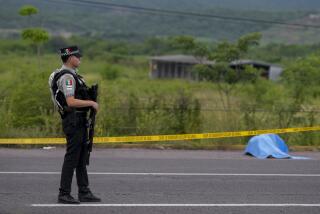Tales of Terror in Colombia’s Kidnapping Capital
- Share via
VALLEDUPAR, Colombia — Famous for its jaunty, accordion-based Vallenato music, this sunbaked Cesar state capital of 300,000 people bustles.
But fear runs deep. The surrounding region has the highest kidnapping rate in all of Colombia.
Chances are good your taxi driver is a guerrilla collaborator.
For decades, every self-respecting Vallenato with money to invest bought land. Then, in the late 1980s, the rebels arrived and land prices dropped by half to about $200 an acre.
“The state is in severe economic crisis,” says Gov. Mauricio Pimiento.
People are buried in debt, and unemployment has hit 16%. It’s worse in the countryside, where a labor surplus is like a rebel recruitment poster.
Beatrice Lacouture became a widow on March 20, 1993, when guerrillas surprised her husband, Fabio, on the family ranch. Workers found him decomposing in the afternoon sun in the cab of his pickup, a bullet in his head, his throat slit.
In October, the couple’s son, Fabio Hernan, was grabbed. The rebels freed him 17 days later in exchange for a sum his mother wouldn’t disclose.
If she risks a trip to the ranch, it’s furtively and via back roads. Recently, she and her driver spotted four rebels on the property. They turned around and fled.
No one grows cotton around Valledupar anymore, but it was while harvesting the crop 40 miles to the north in March 1991 that Armando Pantoja, an architect, was grabbed by 80 armed men.
The kidnapping was typical: Driven into the Sierra Nevada, Pantoja walked and rode horseback for a day until reaching a camp of the National Liberation Army. He slept in a tent and was given a radio during daylight hours to fight boredom.
Mrs. Pantoja met her husband’s captors five times to negotiate the ransom, sometimes rising at 3 a.m. and driving alone into the hills. She took along proof of earnings--bank statements, tax returns. She talked the rebels down to $30,000.
After 26 days of captivity, Pantoja was freed. But it wasn’t over. “I paid in installments,” Pantoja recalls. “I had to take the money to [the port city of] Barranquilla every month or two, where two guys waited for me by a street in Venezuela Park.”
The Pantojas didn’t tell a soul until all the money was paid. It took a year.
If you don’t pay, do they kidnap you again?
“No, they kill you,” he says.
Selema Murcia and her family left Valledupar at dawn in their car the Monday before Easter, headed for a holiday with relatives in Bogota. Two hours later, guerrillas forced an unscheduled stop.
The rebels hustled Selema and her husband, Emilio, into the back seat with their children, 5 and 8. They told them to close their eyes, and drove to where passing cars were no longer heard.
The rebels pronounced it a $1-million kidnapping but were persuaded to accept $10,000.
Selema Murcia, 38, remained while husband and children went for the cash.
Escorted to a farm that served as a hostage motel, she saw half a dozen hostages come and go over two days. No one was mistreated, she says.
On the morning of the third day, Murcia had just finished washing and was sitting on a rock by a stream when she heard gunfire. Someone had notified the Valledupar anti-kidnapping squad; 20 to 30 soldiers were approaching.
The rebels gathered Murcia and four other remaining hostages and tried to flee into the hills. But the hostages became winded.
The guerrillas left them, covering their retreat with semiautomatic rifle fire.
Bullets whizzed all around, Murcia says, recalling the young soldier who reached her.
“You’re free, ma’am!” he shouted. “You’re free!”
More to Read
Sign up for Essential California
The most important California stories and recommendations in your inbox every morning.
You may occasionally receive promotional content from the Los Angeles Times.










